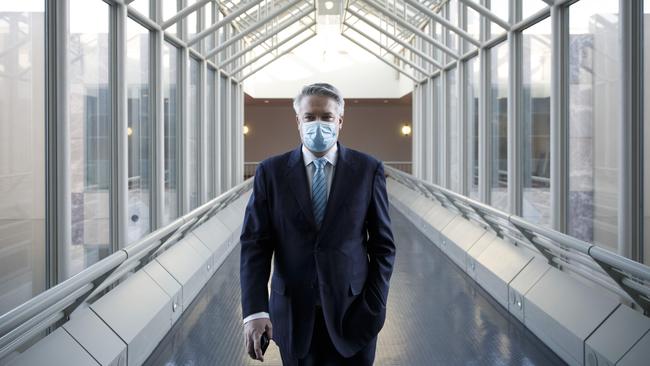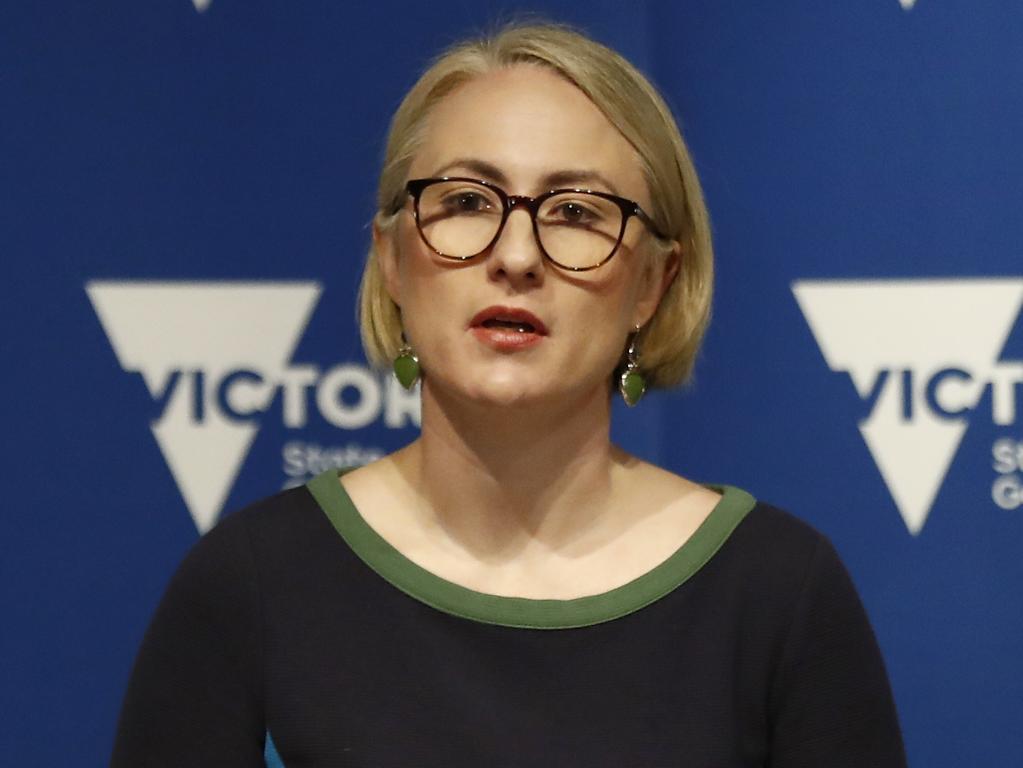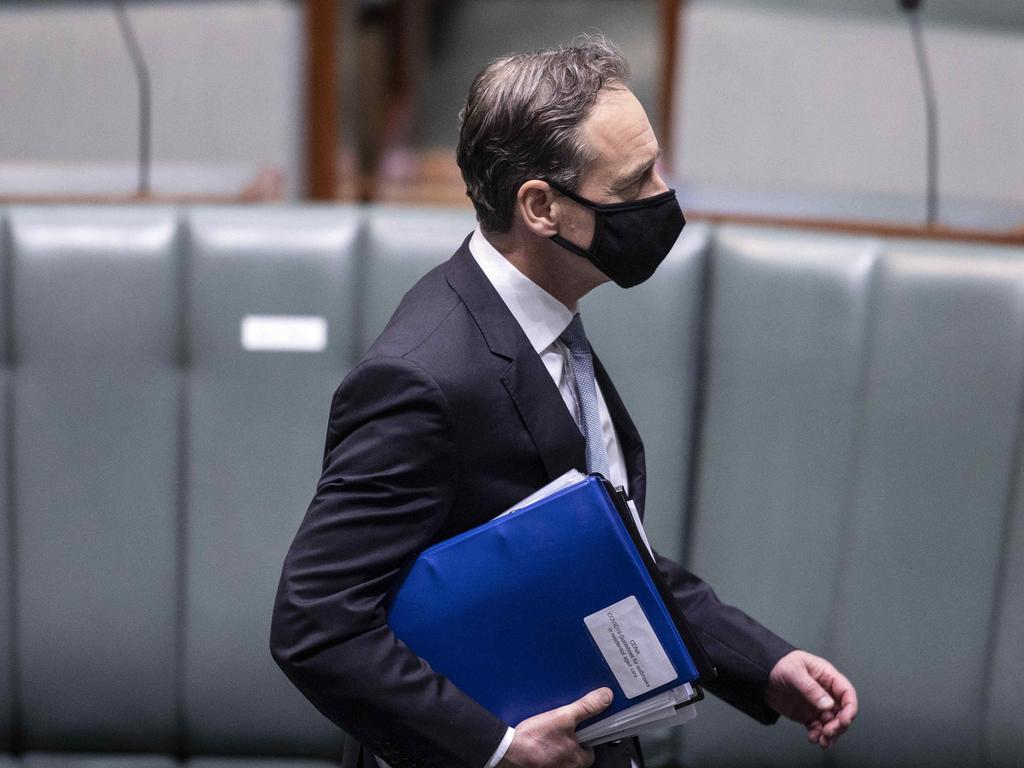Public service mandarins fear work from home is a drag on productivity
Mandarins raise fears of staff missing in action, the waste of office space and sub-par advice in the land of Zoom.

As almost two-thirds of federal public servants, or 93,000 staff, work from home, their masters are worried about the sustainability of pyjama policymaking, rising costs to taxpayers and good government.
Senior officials fear a slide in productivity from staff missing in action, the waste of vacant office space, a lack of mentoring and networking for disengaged junior staff and the potential for sub-par advice in the land of Zoom.
Low-density, COVID-free Canberra, we have a problem, and it has prompted a search by Australian Public Service chiefs for hard data to evaluate the effect of remote working on productivity, culture, service delivery and costs.
According to the Department of Finance, office tenancies cost the federal government $1.34bn a year, or $9575 per public servant.
“It’s fine to ask people about how productive they feel about working from home,” says a senior government figure. “But we need to measure with rigour the outcomes, delivery and true cost to taxpayers if we are to come out of the pandemic in better shape”.
An Australian Public Service Commission census found 64 per cent of 145,000 APS staff worked from home on August 11.
In the ACT, 55 per cent, or 30,600 of 55,000 APS Canberra staff, were working remotely.
Solitude may suit the introverts of Treasury or meeting-averse workhorses, but the big-picture, alpha types at Prime Minister and Cabinet or Foreign Affairs and Trade may feel like a redfin out of Lake Burley Griffin. “It’s ludicrous so many Canberra public servants are working from home, given there’s been no community transmission of coronavirus for weeks,” said a former agency head.
The renewed scrutiny on bureaucracies comes as 3.5 million Australians are receiving JobKeeper and more than one million others are officially unemployed.
Treasury estimates the effective unemployment rate in the ACT is 5.2 per cent, compared with the national rate of 9.9 per cent.
Federal parliament returned from a nine-week hiatus on Monday, with MPs and senators allowed to call into the chambers for the first time during a “remote” sitting fortnight
Scott Morrison calls the APS “the indispensable engine room for any successful government in delivering on its commitments to Australians”.
Yet the capital’s old hands detect a growing apathy, fearing parts of the bureaucracy may be losing firepower.
As one senior executive said, working from home “has been a bold experiment in flexibility, but the question is how sustainable is it to operate like this when the health crisis passes?”
Public servants say they love the autonomy of remote toil, as well as the reduction in laundry costs, childcare and parking fees, and travel times to work. Many are working longer hours and have been deployed to frontline service roles.
But six months on, the “constraint” of state and territory health advice, fatigue and absences are undermining reform projects and longer-term policy work, as less engaged staff and those not used to loose supervision slip into a pandemic funk.
Ministers contacted by The Australian spoke highly of the work ethic of public servants and the necessity of operating in a COVID-safe manner.
Some privately expressed frustration with state and territory health officials, especially in virus-free areas, about advice on working from home and are seeking to quantify the costs.
While surveys of wellbeing can be a proxy for productivity, a committee of departmental chief operating officers, the APSC and the Department of Finance is collecting hard data around the issues of performance, work output, service delivery and hours worked.
The Behavioural Economics Team of the Australian Government (BETA), a crack squad at the Department of the Prime Minister and Cabinet, has been asked to assess staff experiences and attitudes from two surveys.
According to a departmental spokesperson, PM&C “along with BETA is using responses to optimise engagement, productivity and wellbeing of our staff”.
A senior official familiar with the evaluations said Canberra was essentially doing what the private sector was doing to get a sense of how best to provide advice to government, regulation and services in the future. The aim of the exercise is to formulate high-level principles about how agencies can best operate, given the APS plays disparate roles and is geographically dispersed.
“The government is keen to get more from us,” says the official. “Each agency head is having a hard look at their productivity levels and tenancy costs. So far, there’s been no rush by public servants to return to the office.”
According to the Department of Finance’s annual office occupancy report, the average cost for a “work point” — a desk, enclosed office or service counter — is $8000 a year.
The federal government went into the pandemic with 25,000 vacant spaces. On the face of it, that implies $200m in excess rent, although tenancies have fat built in to deal with staff surges.
But the pandemic office clearout bill is mounting and may lead to a rethink of where jobs are located and how work is done.
Finance Minister Mathias Cormann said: “The commonwealth will continue to work across its property portfolio to ensure that accommodation is efficient and fit for purpose”.
According to Finance’s occupancy report, the federal government has a target of 14m2 of usable office space per occupied work point, but typically achieves a density of 16m2.
If every employee attended the office, Safe Work Australia’s 4sq m “rule” at workplaces would easily be satisfied, although with 568 tenancies around the nation, fit-outs, layouts and use vary.
In a vast bureaucracy, it’s been left to agency heads to come up with a transition back-to-work program, often using A and B team formats, five-days-a-fortnight attendance, and making sure social-distancing protocols are in place.
Assistant Minister to the Prime Minister and Cabinet Ben Morton, who assists on public service matters, said: “In the ACT, agency heads make decisions about working from home. But working from home should not impact upon a department meeting its operational requirements. The ACT advice as it stands today encourages working from home.”
In March, the ACT government’s advice was to “work from home if possible” but in late May the advice changed to “working from home if it works for you and your employer”. The ACT has had 113 confirmed cases of COVID-19, and three deaths. There has not been a locally acquired infection in the capital since early last month, and only three cases of community transmission since late April.
Every fortnight the ACT’s Chief Health Officer reviews restrictions, including work-from-home arrangements. According to an ACT government spokesperson, territory public servants “who can work from home have been encouraged to do so”.
In March, the Morrison government implemented a stay on salary increases for senior APS staff. The following month it imposed a wage freeze that will see upcoming pay increases deferred for six months. A revamp of the APS, launched in December to get a more responsive and accountable service, has been delayed.
In early May, the Prime Minister envisaged a return to workplaces by last month, as long as community transmission of the coronavirus was suppressed.
Yet public servants claim they are thriving during a COVID-19-induced liberation. A survey last month of 6000 APS staff by UNSW Canberra and CQUniversity found almost two-thirds agreed they achieved more working from home than when in their regular workplace.
Community and Public Sector Union national secretary Mellissa Donnelly said “the success of the last few months shows that the APS should trust its workers”.
With the October 6 budget six weeks away, Josh Frydenberg said he was comfortable with officials working remotely. About 57 per cent of Treasury’s 1000 staff are doing so.
According to a PM&C spokesman, “roughly half our staff have returned to the office since mid-June, when health advice was updated, with the other half continuing to work remotely”.
Senator Cormann said Finance was structuring its working arrangements to manage the ongoing risk from COVID-19. “The percentage of Finance staff working from the office fluctuates based on business needs,” he said.
The Melbourne and Sydney offices of the Australian Competition & Consumer Commission and Australian Energy Regulator remain closed, while seven others, including Canberra, are open with a COVID-safe plan. Still 70 per cent of ACCC and AER staff in the capital work from home.
ACCC chief operating officer Scott Gregson said staff were used to working flexibly before the crisis.
“We have embraced new technologies for collaboration that I’m sure will make us even more effective after the pandemic is over,” Mr Gregson said.
According to a senior government figure the second-wave of COVID-19 infections in Victoria has kept almost all of the state’s 25,000 APS staff at home.
In NSW, the picture is mixed for 28,000 federal employees, with many managers pushing to keep workers at home. In virus-free Western Australia, most of the 6700 APS staff are back in the office.








To join the conversation, please log in. Don't have an account? Register
Join the conversation, you are commenting as Logout